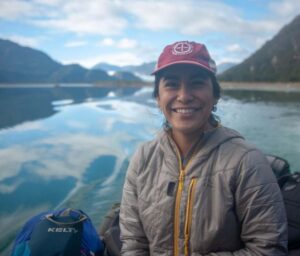Valeria Briones: Seeking collaborative solutions for community-based climate planning
 UMaine master’s student Valeria Briones is collaboratively leading a new project to help tourism-dependent communities in Maine plan for climate change.
UMaine master’s student Valeria Briones is collaboratively leading a new project to help tourism-dependent communities in Maine plan for climate change.
Master’s degree program: Forest Resources
Research program: NRT: Enhancing Conservation Science and Practice
Advisors: Sandra de Urioste-Stone, Daniel Hayes
Mitchell Center project: We’re All in This Together: Participatory Planning for Community-Based Climate Change Adaptation
Feature story: ‘We’re all in this together’: Students lead climate-planning project (Dec. 2020)
What problem(s) are you working to solve?
Our team is currently working on a collaborative project that aims to work with Maine communities to ensure that climate data is tailored and shared in a relevant way, to better address individual community needs. By modifying climate data and engaging with community partners, we can identify relevant information that’s most useful for individual communities. That data can then be used to collaboratively develop planning for future climate change scenarios.
What progress are you making toward solutions?
Our group plans to develop a framework to foster community-based climate change planning with locally scaled data. We aim to collaborate with stakeholders and community partners to gather local knowledge and input from community members about the effects or impacts they feel may threaten their resources and livelihoods most. By gaining local input, we can then collaborate with stakeholders to address challenges related to climate change and co-develop relevant solutions that are specifically tailored to each community.
How could your findings contribute to a sustainable future in Maine and beyond?
This project supports the Mitchell Center’s mission to translate knowledge to action by facilitating community-driven solutions related to climate change within Maine communities that are heavily dependent upon natural resources. Our project aims to develop more effective and accessible tools to share information with tourism stakeholders, such as planners, managers and business owners, to better understand and prepare for future climate change effects.
Why did you get involved with this project?
I became involved with this project when our team realized we could incorporate our individual research interests and backgrounds in work that could address climate change problems faced by Maine communities. The project offered a supportive environment and unique experience to combine our skills and interests to plan and propose our first grant proposal as a student group. This experience would allow us as students and researchers to gain additional skill sets, engage with local stakeholders and work closely together to help create solutions.
What do you like best about working on an interdisciplinary team? What is most challenging?
I find working within an interdisciplinary team rewarding because of the opportunity to problem solve from a multitude of perspectives. It forces you to step back from your set ways of thinking and allow yourself to observe and understand how others view and address the problems you’re working on. While it may be difficult to find common ground when working with individuals from different backgrounds, it adds to the overall experience of working closely with others to find a solution that works best overall.
What sustains you?
Maine is an incredibly unique location to study the impacts of climate change on its vast and diverse forest ecosystems. Being able to live and explore within such a diverse landscape during these uncertain times has been a source of inspiration and motivation for me.
Where do you hope to be in five years?
In five years I hope to continue using remote-sensing techniques to better understand how forest ecosystems are changing in response to climate change in addition to other environmental factors. I hope to be able to work with a diverse group to incorporate biophysical data with citizen science initiatives to allow community members to more deeply connect to their natural surroundings.
